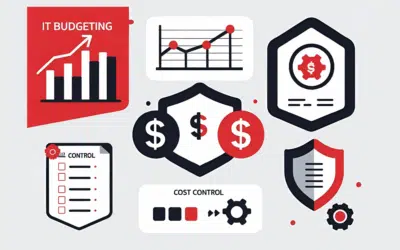Most small business owners try to decide about IT investments without a complete understanding of the options available that they can choose from. One place where this confusion often shows up is when trying to understand the difference between co-managed IT services and managed IT services.
Despite somewhat similar naming conventions, these two IT service models are drastically different. With managed IT, a business is turning over all of its technology initiatives to a third-party partner. With co-managed IT, the business is empowering internal resources to drive technological change with the support of an IT partner. In this post, we will detail the differences between managed IT services and co-managed IT services. Further, we will detail the benefits and drawbacks of co-managed IT services, so you can make an informed decision about what’s best for your business.
What is Managed IT?
Managed IT services is an umbrella term for a variety of different IT services. Typically, managed IT service providers (MSPs) will offer some combination of Help Desk support, proactive monitoring and maintenance, remote and on-site support, and strategic consulting.
In a managed IT arrangement, the service provider will typically offer a range of services, including:
Help Desk support
Assistance with resolving technical issues that arise, usually through phone or email support.
Proactive monitoring and maintenance
24/7 monitoring of your IT infrastructure to identify and address potential issues before they cause problems.
Strategic consulting
Guidance on how to best leverage technology to meet your business goals. This includes future IT investments, decommissioning old hardware, and helping keep applications operating at optimal levels over time.
Disaster recovery and backup
Strategies and tools to ensure that your data is backed up and can be recovered in the event of an outage or disaster.
Staff training on technology and security
Training staff and team members on how to use technology and keep the network secure. For example, training on new software like Office 365 or how to avoid phishing attacks is likely to be conducted by the managed IT provider.
Network security
With managed IT, the whole of your network’s security is handled by your IT partner. From rotating Wi-Fi passwords to monitoring the network for potential intrusion attempts, the managed IT partner has an eye on network health. Additionally, in the event of a breach or ransomware attack, for example, a managed IT provider will take the lead in mitigating the attack and getting your network back operational.
With managed IT, the MSP takes on the role of your in-house IT department. The MSP is responsible for all aspects of your company’s technology, from maintaining and monitoring your network to addressing user issues to consulting on strategic initiatives.
Managed IT services are typically delivered through a flat-fee pricing model, whereby the MSP charges a monthly fee for its services. This fee covers the cost of the MSP’s personnel, as well as any licenses or other tools that the MSP needs to deliver its services.
The main benefits of managed IT services are that it can free up internal resources to focus on other initiatives and it can provide peace of mind knowing that your company’s technology is in good hands.
What is Co-Managed IT?
The co-managed IT services model is one whereby the MSP provides supplementary support to internal IT staff, rather than taking on the role of the in-house IT department. In a co-managed IT arrangement, the MSP and internal IT team work together to manage the company’s technology.
Co-managed IT services include some of the services listed above delivered at the request or direction of the internal IT staff.
With co-managed IT, the internal IT team remains responsible for driving technological change within the company, with the support of the MSP. The co-managed IT model can take a variety of different forms, but typically the MSP will provide support as needed, rather than on a retainer basis. This allows businesses to get the support they need, when they need it, without incurring the cost of a full-time MSP.
For example, Axxys Technologies offers billing is based on the a la carte management tools, security tools, and labor per month for the agreed upon services under the co-managed IT agreement. While there are a minimum number of hours for this service per month, Axxys works with the clients to ensure allocated hours are used on the greatest priority tasks to keep costs in line with expectations.
The main benefits of co-managed IT services are that they can be more cost-effective than managed IT services, and they can provide greater flexibility in terms of how your company’s technology is managed. Additionally, when your internal team is leveraging a third party to support their efforts, they gain the benefit of the additional expertise and experience the IT partner provides.
The main drawback of co-managed IT services is that you may not have as much control over your company’s technology as you would like, as the MSP will still be involved in the network’s management. Co-managed IT services are a collaboration, and choosing technology where your IT partner is not an expert can have significant consequences. Furthermore, in the event of a network outage or security breach, it will most often fall on your internal team to take the lead in solving the problem.
Differences between Managed IT and Co-Managed IT
There are a few key differences between managed IT and co-managed IT services.
First, managed IT services are typically offered by a single provider, while co-managed IT services involve a partnership between an in-house IT team and an external MSP. This partnership can provide businesses with access to new technology and increased depth of expertise.
Second, managed IT services are more reactive in nature. This means that providers offer support after problems have already occurred. Co-managed IT services, on the other hand, are proactive in nature. This means that both parties work together to prevent problems from happening in the first place.
Finally, co-managed IT services can sometimes be more expensive than a fully managed solution. Remember, many fully managed IT models charge a single flat fee for monthly network management. Many co-managed service models are not a flat rate but rather variable costs depending on need. This means a particularly busy month can get expensive for your business. However, the benefits of co-managed IT can be well worth the cost for businesses that want to get the most out of their network and systems.
Which IT Services Model is Right for Your Business?
Choosing between managed IT services and co-managed IT services comes down to a few different factors. First, you need to consider your budget. If you have the budget for a full-time MSP, then managed IT services may be the right choice for you. If you’re looking to save money, or if you want more flexibility in how to manage your company’s technology, then co-managed IT services may be a better option.
Second, you need to consider your company’s needs relative to the IT staff you have available. Co-managed IT services are a great choice for organizations lacking the internal IT expertise and/or the necessary time to complete an IT task. Co-managed IT services augment your existing IT team with both expertise and time where you might be in need of an extra expert set of hands.
Third, you need to consider your company culture. If you prefer to have more control over your company’s technology, then managed IT services may be the right choice. If you’re open to working with an MSP and sharing responsibility for your company’s technology, then co-managed IT services may be a better option.
Moving Forward with an IT Partner
The bottom line is that there is no one-size-fits-all answer when it comes to choosing between managed IT services and co-managed IT services. The best way to decide which option is right for your business is to sit down with an MSP and discuss your needs and preferences. With their help, you should be able to make an informed decision that will help you get the most out of your company’s technology.
Choosing the right type of IT support for your business can be a challenge. There are a lot of different options out there, and it’s important to find one that is the right fit for your needs. If you’re not sure if co-managed IT is right for you, reach out to Axxys Technologies for a consultation. We can help you easily assess your needs and make a recommendation on the best course of action for your business. Contact Axxys Technologies today.








